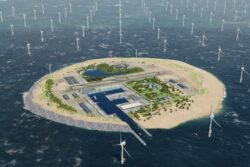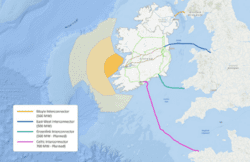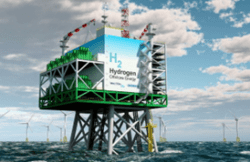“The sea, the great unifier, is man’s only hope. Now, as never before, the old phrase has a literal meaning: we are all in the same boat.” – Jacques Yves Cousteau
Offshore sustainability is the set of activities conducted in offshore environments, such as offshore oil and gas exploration, renewable energy projects, and other marine-related industries, that minimizes environmental and social impact. This concept involves addressing the ecological, social, and economic impacts of offshore activities to promote long-term environmental health and the well-being of communities. Innovation in this space involves the development and implementation of new technologies, practices, and strategies to minimize the environmental impact of offshore activities while promoting economic and social sustainability.
Offshore Wind Farms
Offshore wind farms are large-scale installations of wind turbines located in bodies of water, typically in the ocean or seas. These wind farms harness the power of the wind to generate electricity. Offshore wind farms are situated in bodies of water where the wind is strong and consistent. Coastal areas and shallow waters are often chosen for ease of construction and maintenance. The wind turbines used in offshore wind farms are specifically designed to withstand the harsh marine environment. They are mounted on towers fixed to the seabed or floating structures, depending on the depth of the water. In deeper waters, where fixed foundations are not feasible, floating structures are used. These floating platforms are anchored to the seabed and allow for the installation of turbines in deeper and more remote locations. The electricity generated by the offshore wind turbines is transported to the shore through undersea cables. Once onshore, it is distributed through the existing electrical grid.
consistent. Coastal areas and shallow waters are often chosen for ease of construction and maintenance. The wind turbines used in offshore wind farms are specifically designed to withstand the harsh marine environment. They are mounted on towers fixed to the seabed or floating structures, depending on the depth of the water. In deeper waters, where fixed foundations are not feasible, floating structures are used. These floating platforms are anchored to the seabed and allow for the installation of turbines in deeper and more remote locations. The electricity generated by the offshore wind turbines is transported to the shore through undersea cables. Once onshore, it is distributed through the existing electrical grid.
Green Hydrogen
Hydrogen offers much promise in the search for Net Zero compatible alternatives to fossil-based fuels and feedstocks. Not only does it produce zero harmful emissions when consumed, but pound for pound, hydrogen contains almost three times as much energy as fossil fuels. Unlike fossil fuels, there are no vast deposits of hydrogen in its molecular form (H2) that can be extracted from the ground. Hydrogen must therefore be produced through a chemical process involving other molecular compounds. And unfortunately, the most prevalent hydrogen production process today results in significant carbon emissions. In other words,  whilst hydrogen’s consumption is carbon-free, it is production currently is not. There are alternative hydrogen production methods that are not as carbon intensive. Green hydrogen emits no carbon during its production and is powered entirely by renewable electricity, which Ireland could have in abundant supply in the form of offshore wind. Green hydrogen production is fully consistent with the Net Zero route and is the most compatible option with the EU’s climate neutrality and zero pollution goal in the long term and the most coherent with an integrated energy system. It relies on technologies that have long been known, based on electrolysis, which combines water with electricity to form hydrogen. Water is a key feedstock in the production of green hydrogen with about 20 kg of water needed to produce about 1 kg of hydrogen via electrolysis considering losses. Water can be obtained from fresh water sources, or from sea water where it would need to be desalinated. The water needs to be as pure as possible as any impurities will have a major impact on the life of the electrolyser, therefore water treatment plants will be required for any green hydrogen production facility. In addition to being used as feedstock for the hydrogen production process, water can also be used to cool the plant equipment.
whilst hydrogen’s consumption is carbon-free, it is production currently is not. There are alternative hydrogen production methods that are not as carbon intensive. Green hydrogen emits no carbon during its production and is powered entirely by renewable electricity, which Ireland could have in abundant supply in the form of offshore wind. Green hydrogen production is fully consistent with the Net Zero route and is the most compatible option with the EU’s climate neutrality and zero pollution goal in the long term and the most coherent with an integrated energy system. It relies on technologies that have long been known, based on electrolysis, which combines water with electricity to form hydrogen. Water is a key feedstock in the production of green hydrogen with about 20 kg of water needed to produce about 1 kg of hydrogen via electrolysis considering losses. Water can be obtained from fresh water sources, or from sea water where it would need to be desalinated. The water needs to be as pure as possible as any impurities will have a major impact on the life of the electrolyser, therefore water treatment plants will be required for any green hydrogen production facility. In addition to being used as feedstock for the hydrogen production process, water can also be used to cool the plant equipment. Access to significant amounts of water is therefore a key consideration for the siting of a green hydrogen production facility. Green hydrogen will therefore be most economical in locations that have the optimal combination of abundant renewable resources and access to water, along with the capability to export to large demand centres. Green hydrogen is likely to play a vital role in the journey to Net Zero, and demand for it is projected to increase dramatically.
Access to significant amounts of water is therefore a key consideration for the siting of a green hydrogen production facility. Green hydrogen will therefore be most economical in locations that have the optimal combination of abundant renewable resources and access to water, along with the capability to export to large demand centres. Green hydrogen is likely to play a vital role in the journey to Net Zero, and demand for it is projected to increase dramatically.
Innovations in Offshore Sustainability
Denmark
Denmark has been planning to build an ambitious project known as the “Energy Island” (Energiøen in Danish). The concept involves the construction of a large artificial island in the North Sea, which would serve as a hub for offshore wind farms. The idea is to harness wind  energy on a large scale and distribute it to Denmark and neighbouring countries. The primary purpose of the Energy Island is to generate renewable energy, particularly from offshore wind farms. The location in the North Sea is chosen for its favourable wind conditions. The Energy Island is intended to be a central point for connecting and distributing electricity to surrounding countries, such as Germany, the Netherlands, and potentially other European nations. This interconnection aims to enhance the integration of renewable energy sources into the European power grid. The artificial island would be surrounded by numerous offshore wind turbines to capture wind energy efficiently. These wind farms are expected to have a substantial capacity, contributing significantly to Denmark’s and Europe’s renewable energy goals.
energy on a large scale and distribute it to Denmark and neighbouring countries. The primary purpose of the Energy Island is to generate renewable energy, particularly from offshore wind farms. The location in the North Sea is chosen for its favourable wind conditions. The Energy Island is intended to be a central point for connecting and distributing electricity to surrounding countries, such as Germany, the Netherlands, and potentially other European nations. This interconnection aims to enhance the integration of renewable energy sources into the European power grid. The artificial island would be surrounded by numerous offshore wind turbines to capture wind energy efficiently. These wind farms are expected to have a substantial capacity, contributing significantly to Denmark’s and Europe’s renewable energy goals.  The project also envisions the use of excess electricity generated during periods of low demand to produce hydrogen through electrolysis. This green hydrogen can be stored and used as a clean energy source in various sectors, such as industry and transportation. Denmark’s Energy Island is part of a broader effort to collaborate with neighbouring countries and strengthen regional cooperation in achieving common climate and energy goals. The Denmark energy island will collect enormous amounts of green energy from adjacent offshore wind farms, which will be distributed to the electricity grid in Denmark and into Europe. It is the beginning of a new era in offshore wind energy production, where energy islands will play a crucial part in phasing out fossil fuels and accelerating the green transformation.
The project also envisions the use of excess electricity generated during periods of low demand to produce hydrogen through electrolysis. This green hydrogen can be stored and used as a clean energy source in various sectors, such as industry and transportation. Denmark’s Energy Island is part of a broader effort to collaborate with neighbouring countries and strengthen regional cooperation in achieving common climate and energy goals. The Denmark energy island will collect enormous amounts of green energy from adjacent offshore wind farms, which will be distributed to the electricity grid in Denmark and into Europe. It is the beginning of a new era in offshore wind energy production, where energy islands will play a crucial part in phasing out fossil fuels and accelerating the green transformation.
Ireland
Situated at the western end of Ireland the Shannon Estuary is well-positioned to serve as the “go to” destination for connecting west coast offshore wind power to domestic demand in the near term. Multiple long-distance high-voltage direct current (HVDC) submarine cables will be required for 10+ GW of Atlantic offshore wind power to reach Ireland’s shores. The Shannon Estuary can also act as a conduit delivering electricity to the European grid by connecting to one of Ireland’s high-voltage interconnects. Additionally, the hybrid project concept offers an alternative route through which electricity generated by Atlantic offshore wind could be conveyed directly to Europe without ever touching Ireland’s shores. SuperGrid, a pan-European transmission network that would allow huge volumes of electricity to move across great distances. The SuperGrid offers great promise for the rapid development of renewable generation across Europe and, particularly, for Ireland considering the size of Ireland’s offshore wind resource compared to its domestic demand. Inherent in the realisation of the SuperGrid is the advancement of higher capacity transmission technologies, such as those using special superconducting materials. Though not ready for implementation today, the swift advancement and deployment of long-distance high-capacity superconducting cables would be a welcome boon for the SuperGrid and for Atlantic offshore wind.
one of Ireland’s high-voltage interconnects. Additionally, the hybrid project concept offers an alternative route through which electricity generated by Atlantic offshore wind could be conveyed directly to Europe without ever touching Ireland’s shores. SuperGrid, a pan-European transmission network that would allow huge volumes of electricity to move across great distances. The SuperGrid offers great promise for the rapid development of renewable generation across Europe and, particularly, for Ireland considering the size of Ireland’s offshore wind resource compared to its domestic demand. Inherent in the realisation of the SuperGrid is the advancement of higher capacity transmission technologies, such as those using special superconducting materials. Though not ready for implementation today, the swift advancement and deployment of long-distance high-capacity superconducting cables would be a welcome boon for the SuperGrid and for Atlantic offshore wind.
 WindEurope calculated that 42% of the Irish section of the Atlantic is available for offshore wind. This calculation may include the vast expanses of the Irish Atlantic that are greater than 1,000m depth (and therefore not feasible for offshore wind), making the percentage much higher within the Shannon Estuary capture area. If this percentage is conservatively applied uniformly, the result is over 70 GW of offshore wind potential within a 36-hr wet-tow from the Shannon Estuary. If delivered as electricity, a significant expansion of the high-voltage transmission network will be required, both on- and offshore Ireland. The island of Ireland is currently connected to the European grid only via Great Britain, and these high-voltage interconnects will have a combined capacity of 1.5 GW by 2024 once the 500 MW Greenlink Interconnector is completed. A planning application for a direct link between Ireland and France – the 700 MW capacity Celtic Interconnector – was recently approved and is anticipated to be built and energised by 2026.
WindEurope calculated that 42% of the Irish section of the Atlantic is available for offshore wind. This calculation may include the vast expanses of the Irish Atlantic that are greater than 1,000m depth (and therefore not feasible for offshore wind), making the percentage much higher within the Shannon Estuary capture area. If this percentage is conservatively applied uniformly, the result is over 70 GW of offshore wind potential within a 36-hr wet-tow from the Shannon Estuary. If delivered as electricity, a significant expansion of the high-voltage transmission network will be required, both on- and offshore Ireland. The island of Ireland is currently connected to the European grid only via Great Britain, and these high-voltage interconnects will have a combined capacity of 1.5 GW by 2024 once the 500 MW Greenlink Interconnector is completed. A planning application for a direct link between Ireland and France – the 700 MW capacity Celtic Interconnector – was recently approved and is anticipated to be built and energised by 2026.
The abundance of potential energy available from Atlantic floating offshore wind, along with the potential to produce green hydrogen and derivatives, presents an enormous opportunity for the Ireland. This will require significant industry and Government collaboration.
Currently, hydrogen production from renewable sources is limited (global electrolyser capacity today stands at just over 0.3 GW), but this is set to change with the global focus on its development. In July 2022, the Irish Government set a target for 2 GW of green hydrogen production capacity to be established by 2030. Though quite an ambitious target, green hydrogen production is being accelerated across the EU and its prospects are evolving quickly due to various initiatives Green hydrogen is likely to play a vital role in the journey to Net Zero, and demand for it is projected to increase dramatically. Considering its immense untapped renewable sources – particularly in offshore wind – there is a significant opportunity for Ireland to become a major producer of green hydrogen and its sustainable derivatives. It is important to think forward and employ solutions that are “future-proof” especially in a rapidly changing world. With Europe’s recent energy crisis brought on by the dependency on imported gas, it is more critical than ever to seek energy independence and secure energy supply by investing in diversified and indigenous energy resources while becoming more sustainable.
Offshore Green Hydrogen Production
Another way of producing green hydrogen is to position the electrolyser facilities offshore in the wind farm and then transport the hydrogen onshore via pipeline or even in a ship. Offshore green hydrogen production can take place through either decentralised or centralised electrolysis. Decentralised electrolysis entails the mounting of electrolysers on each turbine structure, effectively creating an array of electrolysers whose hydrogen output is marshalled via a manifold to an export pipeline. Centralised offshore electrolysis entails a single, larger, electrolysis facility mounted on a separate platform that gathers electricity from the wind turbines array to produce green hydrogen and then send it to an export pipeline.
centralised electrolysis. Decentralised electrolysis entails the mounting of electrolysers on each turbine structure, effectively creating an array of electrolysers whose hydrogen output is marshalled via a manifold to an export pipeline. Centralised offshore electrolysis entails a single, larger, electrolysis facility mounted on a separate platform that gathers electricity from the wind turbines array to produce green hydrogen and then send it to an export pipeline.
Collaboration between Data Centres and Offshore Energy
Data centres are now a significant feature of electricity demand, and they are also a core infrastructure enabler of a technology-rich, innovative economy. There are currently concerns that data centres are placing too much demand on the electricity grid.
Danish engineering company Ramboll is investigating installing a data centre on a proposed artificial island wind farm in the North Sea. Global Connect has the most extensive high-capacity network and experience in Northern Europe with more than 100,000 km of fibre across the region. Data consumption is expected to rise requiring a capacity expansion of the grid transporting data between the North Sea countries, and a smart North Sea Energy Island offers a natural intersection for this grid, while also being a reliable source of renewable energy to power the digitisation.
Norwegian energy company Earth Wind & Power (EWP) is set to offtake up to 400MW of excess and pre-grid offshore wind power to supply electricity to data centre infrastructure in Northern Europe. EWP HPC provides, establishes, and operates data centre infrastructure at power production sites, and EWP DC provides a decentralised, distributed network of infrastructure that allows data processing and handling to be kept within national borders, thus removing the dependency on external providers.
Nautilus Data Technologies plan to create an innovative floating, water-cooled data centre in Ireland. The project, a pilot project for energy efficiency uses their patented Total Resource Usage Effectiveness (TRUE) cooling to provide a Zero Impact Cooling System. The data centre will operate at the highest level of energy efficiency, with no water consumption, no refrigerants, no water treatment chemicals, no wastewater, and no harm to wildlife.
The Art Data Centre campus has been granted planning permission to build six data halls of 33 MW each, an Energy Centre, and Vertical Farm. It has access to 200 MW of power from both the network grid and gas generation on site and aligns with the current CRU requirements for dispatchable Power and being in an unconstrained area. The energy centre turbines have been designed to run on green hydrogen.
Google has signed power purchase agreements (PPAs) for over 700 megawatts of clean energy to power its European data centres.
The company’s announcement is in line with its ambitious goal to achieve net-zero emissions across all of its operations and value chain by 2030, as per Google’s Environmental Report
Conclusion
CAI Data Centre Services are investing in the future to be the commissioning partner of choice for our clients who are driving the use of offshore energy sources as their source of clean energy. Our project delivery teams are constantly upskilled to commission facilities with alternative energy sources. With our eye firmly on the future, we will continue to serve our clients and society for the improvement of the industry.
